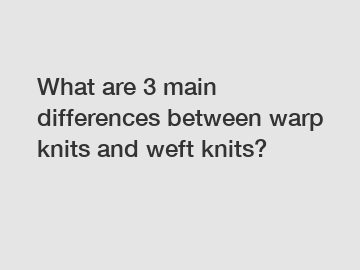What are 3 main differences between warp knits and weft knits?
What are 3 main differences between warp knits and weft knits?
When it comes to textile manufacturing, two major techniques stand out: warp knitting and weft knitting. While both methods involve interlocking loops of yarn, there are distinct differences between the two. Understanding these variations is crucial for manufacturers, designers, and consumers alike. So, let's delve into the topic and explore the three main differences between warp knits and weft knits:
1. Structure and Fabric Characteristics:

Warp knits are created by intermeshing yarns in a lengthwise direction, parallel to the fabric edges. This results in fabric stability and a relatively low stretch, making it ideal for applications requiring shape retention, such as lingerie, sportswear, and hosiery. On the other hand, weft knits are produced by interlocking yarns in a crosswise direction, perpendicular to the fabric edges. This gives weft knits greater stretchability and a more fluid drape, making them suitable for garments that require elasticity and comfort, like t-shirts, sweaters, and socks. The structural difference between warp and weft knits fundamentally affects the fabric's characteristics and performance.
2. Production Process:
Another significant difference lies in the production process of both types. Warp knitting typically involves multiple yarn guide bars and complex machines, allowing for simultaneous and controlled movement of each yarn. This process allows for flexibility in patterning and the inclusion of different colors, textures, or yarn types within a single fabric. In contrast, weft knitting usually involves single or double bed knitting machines, which move the yarn horizontally across the fabric width. Weft knitting is generally simpler and faster than warp knitting, making it suitable for large-scale production and more cost-effective for bulk manufacturing.
3. Fabric Texture and Appearance:
Warp and weft knits also differ in terms of their texture and visual appearance. Thanks to their interlocking loops, warp knits often have a fine and intricate texture, resembling a woven fabric. The beautiful drape of warp knits allows for the creation of garments with a luxurious and tailored feel. In contrast, weft knits tend to have a more varied texture, given the different knitting techniques used. Common weft knit styles include jersey, rib, and interlock, each offering a distinct texture and appearance. Weft knits can range from lightweight and smooth to thick and textured, making them suitable for a wide range of applications.
In conclusion, the differences between warp knits and weft knits are substantial and should be considered when choosing fabrics for specific products. While warp knits offer stability, low stretch, and intricate textures, weft knits provide greater elasticity, comfort, and a variety of surface textures. Manufacturers and designers must carefully assess the desired characteristics of the final product and select the appropriate knitting technique accordingly.
By understanding the unique qualities of both warp knits and weft knits, businesses can ensure the production of textiles that align with consumer expectations. Whether it's creating form-fitting lingerie or stretchy activewear, the choice between warp and weft knits plays a crucial role in achieving the desired outcome. So, next time you buy or wear a garment, take a moment to appreciate the complexities of its production and the thoughtful selection of knitting techniques that contribute to its comfort and style.
If you want to learn more, please visit our website microfiber material for sale, cleaning cloth manufacturers, warp knitted terry fabric.


